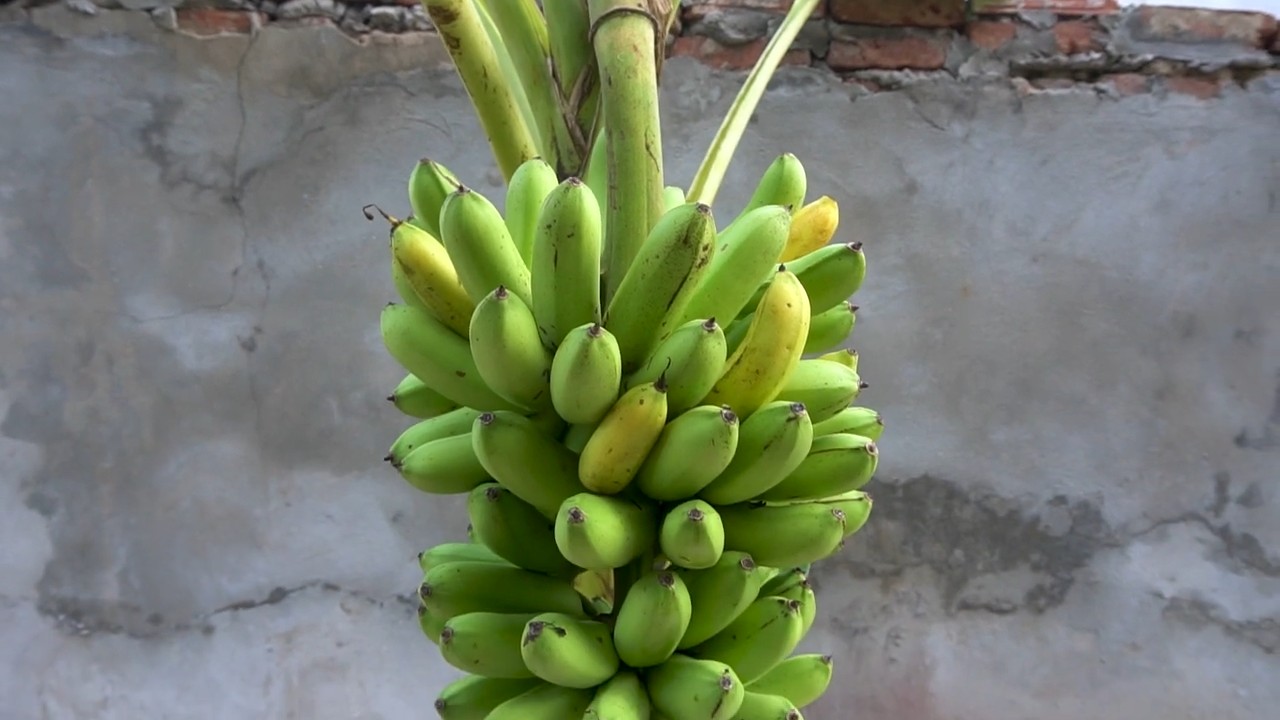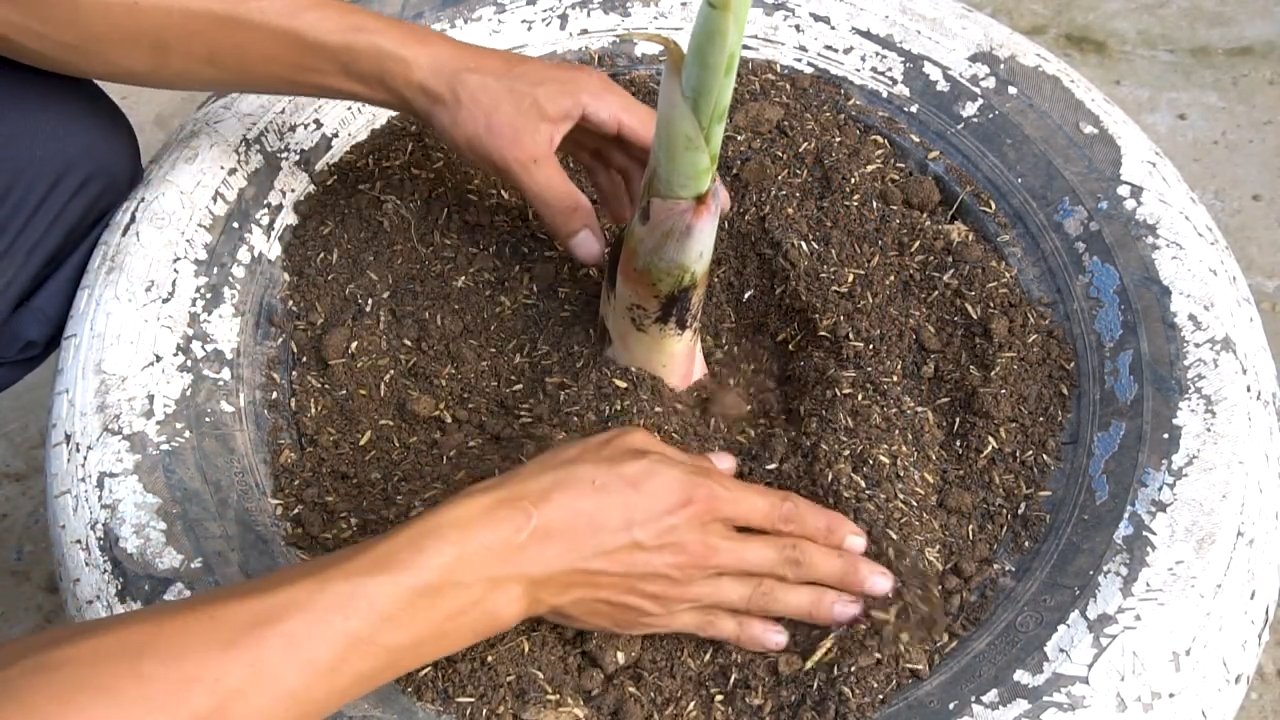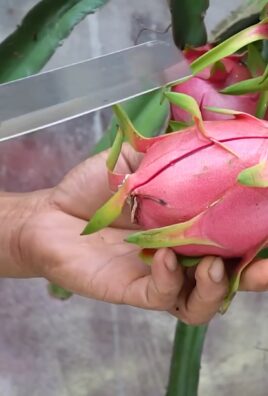Grow Banana Tree Fast? Absolutely! Imagine plucking a perfectly ripe, homegrown banana right from your own backyard. Sounds like a tropical dream, right? Well, it doesn’t have to be just a dream! For centuries, bananas have been a staple food and a symbol of abundance in many cultures, from Southeast Asia to South America. But you don’t need a tropical climate to enjoy the fruits of your labor.
I’m here to let you in on some amazing DIY tricks and hacks that will help you grow banana tree fast, even if you’re a beginner gardener. Forget waiting years for your first harvest! We’ll explore simple, effective techniques to accelerate growth, optimize your soil, and protect your precious banana plant from common problems.
Why do you need these DIY tricks? Because growing bananas can be tricky! Many people struggle with slow growth, nutrient deficiencies, and pest infestations. But with the right knowledge and a little bit of elbow grease, you can overcome these challenges and enjoy a bountiful banana harvest sooner than you think. So, grab your gardening gloves, and let’s get started on this exciting journey to homegrown bananas!

Growing Banana Trees Faster: My DIY Secrets
Okay, banana lovers, let’s talk about speeding up the banana-growing process! I know, waiting for those delicious fruits can feel like an eternity. But fear not, because I’m going to share my tried-and-true DIY methods to help you get your banana tree thriving and producing sooner than you thought possible. We’re going to cover everything from soil preparation to clever fertilization techniques. Let’s get started!
Choosing the Right Banana Variety
Before we dive into the nitty-gritty, it’s crucial to pick the right banana variety for your climate and desired outcome. Some varieties are naturally faster growers than others.
* Dwarf Cavendish: A popular choice for its manageable size and relatively quick fruit production.
* Williams: Another fast-growing variety, known for its sweet and flavorful bananas.
* Rajapuri: A cold-hardy option that can tolerate slightly cooler temperatures and still produce quickly.
* Goldfinger: A disease-resistant variety that is known for its fast growth and unique apple-like flavor.
Choosing a variety suited to your region will give you a head start!
Preparing the Perfect Planting Site
Banana trees are heavy feeders and need a nutrient-rich environment to flourish. Proper soil preparation is absolutely key to accelerating their growth.
* Sunlight: Banana trees crave sunlight! Aim for at least 6-8 hours of direct sunlight per day.
* Soil Drainage: They hate soggy feet! Ensure your soil drains well to prevent root rot.
* Soil Enrichment: This is where the magic happens. We’re going to create a super-charged soil mix.
Step-by-Step Planting Guide
1. Dig a Large Hole: The hole should be at least twice as wide and deep as the banana plant’s root ball. This gives the roots plenty of room to spread and establish themselves.
2. Create a Super Soil Mix: This is my secret weapon! In a large container or wheelbarrow, combine the following:
* Original Soil: Use the soil you dug out of the hole as a base.
* Compost: Add a generous amount of compost (about 1/3 of the total volume). Compost is packed with nutrients and beneficial microbes.
* Well-rotted Manure: This provides a slow-release source of nitrogen, which is essential for leaf growth. Use about 1/4 of the total volume.
* Coco Coir or Peat Moss: This helps improve drainage and water retention. Use about 1/4 of the total volume.
* Perlite: This further enhances drainage and aeration. Add about 10% of the total volume.
* Bone Meal: This provides phosphorus, which is crucial for root development. Add according to the package instructions.
* Epsom Salts: Magnesium is important for chlorophyll production and overall plant health. Add about a tablespoon per plant.
Mix everything thoroughly until well combined.
3. Planting the Banana Tree:
* Carefully remove the banana plant from its container, being gentle with the roots.
* Place the plant in the center of the hole, ensuring that the top of the root ball is level with the surrounding soil.
* Backfill the hole with your super soil mix, gently tamping it down as you go.
* Water thoroughly after planting.
4. Mulching: Apply a thick layer of organic mulch around the base of the banana tree, keeping it a few inches away from the trunk. Mulch helps retain moisture, suppress weeds, and regulate soil temperature. I like to use straw, wood chips, or shredded leaves.
Boosting Growth with Strategic Fertilization
Banana trees are hungry plants, and regular fertilization is essential for rapid growth and fruit production.
* Nitrogen: Promotes lush green growth.
* Phosphorus: Supports strong root development.
* Potassium: Crucial for fruit production and overall plant health.
Here’s my fertilization schedule:
1. Initial Feeding (2 weeks after planting): Use a balanced fertilizer (e.g., 10-10-10) diluted to half strength. This gives the plant a gentle boost without overwhelming it.
2. Monthly Feeding (during the growing season): Switch to a fertilizer with a higher potassium content (e.g., 8-10-12). This will encourage flowering and fruit development. I like to use a liquid fertilizer for easy application.
3. Organic Options: If you prefer organic methods, consider using compost tea, fish emulsion, or seaweed extract. These are all excellent sources of nutrients.
4. Banana Peel Fertilizer: Don’t throw away those banana peels! They’re packed with potassium. You can bury them around the base of the tree or make a banana peel tea by soaking them in water for a few days.
Watering Wisely
Consistent watering is vital, especially during the hot summer months.
* Deep Watering: Water deeply and infrequently, allowing the soil to dry out slightly between waterings. This encourages deep root growth.
* Check Soil Moisture: Stick your finger into the soil to check the moisture level. If the top inch or two feels dry, it’s time to water.
* Avoid Overwatering: Soggy soil can lead to root rot, which can be fatal to banana trees.
* Watering Frequency: In general, water 2-3 times per week during the growing season, and less frequently during the dormant season.
Pruning for Optimal Growth
Pruning can help direct the plant’s energy towards fruit production.
* Remove Dead or Damaged Leaves: Regularly remove any dead, yellowing, or damaged leaves. This improves air circulation and prevents the spread of disease.
* Sucker Management: Banana trees produce suckers (small offshoots) from the base of the plant. While you can allow a few suckers to grow to create a clump, it’s important to remove excess suckers to prevent them from competing with the main plant for resources. I usually leave 2-3 suckers.
* How to Remove Suckers: Use a sharp knife or pruning shears to cut the suckers off at ground level. You can also dig them up and transplant them to start new banana trees.
Protecting Your Banana Tree
Protecting your banana tree from pests and diseases is crucial for its health and productivity.
* Pest Control: Keep an eye out for common banana pests such as aphids, spider mites, and nematodes. Treat infestations promptly with insecticidal soap or neem oil.
* Disease Prevention: Ensure good air circulation around the plant to prevent fungal diseases. Avoid overhead watering, which can create a humid environment that encourages disease development.
* Cold Protection: If you live in an area with cold winters, you’ll need to protect your banana tree from frost. You can wrap the trunk with burlap or move the plant indoors if it’s in a container.
Extra Tips and Tricks
* Epsom Salt Boost: I mentioned this earlier, but it’s worth repeating. A monthly application of Epsom salts (about a tablespoon per plant) can work wonders for banana tree growth.
* Coffee Grounds: Coffee grounds are a great source of nitrogen and other nutrients. Sprinkle them around the base of the tree or add them to your compost pile.
* Companion Planting: Plant beneficial companion plants around your banana tree to attract pollinators and repel pests. Some good options include marigolds, basil, and nasturtiums.
* Patience: While these tips will help you speed up the process, remember that growing banana trees takes time. Be patient and enjoy the journey!
Harvesting Your Bananas
Knowing when to harvest your bananas is key to enjoying their delicious flavor.
* Timing: Bananas are typically ready to harvest about 90-150 days after flowering.
* Signs of Ripeness: The bananas will become plump and rounded, and the ridges on the fruit will become less prominent. The color of the peel will also change from green to yellow.
* Harvesting: Use a sharp knife to cut the entire bunch of bananas from the tree.
* Ripening: Hang the bunch of bananas in a cool, dry place to ripen. You can also place them in a paper bag with an apple or banana to speed up the ripening process.
And there you have it! My comprehensive guide to growing banana trees faster. By following these tips and tricks, you’ll be enjoying homegrown bananas in no time. Happy gardening!

Conclusion
So, there you have it! Unlocking the secrets to growing a banana tree fast isn’t about magic; it’s about understanding the plant’s needs and providing the optimal environment for it to thrive. This DIY approach, focusing on enriched soil, consistent watering, strategic sunlight exposure, and the occasional boost from natural fertilizers, offers a cost-effective and incredibly rewarding way to cultivate your own tropical paradise.
Why is this a must-try? Because store-bought bananas, while convenient, often lack the vibrant flavor and freshness of homegrown fruit. Plus, the sheer joy of nurturing a plant from a small pup to a fruit-bearing tree is an experience unlike any other. Imagine stepping into your backyard and harvesting your own sweet, creamy bananas – a true testament to your gardening skills and a delicious reward for your efforts.
But the benefits extend beyond just the fruit. Banana trees are stunning additions to any landscape, providing lush greenery and a touch of the tropics. They also contribute to a healthier environment by absorbing carbon dioxide and releasing oxygen. And let’s not forget the satisfaction of knowing you’re growing your own food, reducing your reliance on commercially produced products.
Ready to take your banana growing to the next level? Consider these variations and suggestions:
* Experiment with different banana varieties: From the classic Cavendish to the sweeter Lady Finger or the unique Blue Java, each variety offers a distinct flavor profile and growth habit. Research which varieties thrive in your climate and choose one that suits your taste.
* Try companion planting: Certain plants, like ginger, beans, and marigolds, can benefit banana trees by providing nutrients, attracting pollinators, or repelling pests. Research companion planting strategies to create a thriving ecosystem around your banana tree.
* Explore different fertilizer options: While the DIY fertilizer mentioned earlier is a great starting point, you can also experiment with other organic options like compost tea, fish emulsion, or bone meal. Monitor your plant’s growth and adjust your fertilizer regimen accordingly.
* Consider container gardening: If you live in a colder climate, growing your banana tree in a large container allows you to move it indoors during the winter months. Choose a container with good drainage and use a well-draining potting mix.
Don’t be afraid to get your hands dirty and experiment! Gardening is a journey of learning and discovery, and there’s no one-size-fits-all approach. The key is to observe your plant, understand its needs, and adapt your techniques accordingly.
We are confident that by following these tips, you’ll be well on your way to enjoying a bountiful harvest of homegrown bananas. We encourage you to try this DIY trick for growing a banana tree fast and share your experiences with us! Post photos of your banana trees, share your tips and tricks, and let us know what worked best for you. Together, we can create a community of passionate banana growers and spread the joy of homegrown fruit. So, grab your gardening gloves, get ready to nurture your own banana tree, and prepare to be amazed by the results! Happy growing!
Frequently Asked Questions (FAQ)
What is the best location for planting a banana tree?
The ideal location for a banana tree is one that receives at least 6-8 hours of direct sunlight per day. Banana trees thrive in warm, sunny environments. It should also be sheltered from strong winds, which can damage the large leaves. The soil should be well-draining and rich in organic matter. Consider the mature size of the banana tree when choosing a location, as some varieties can grow quite large.
How often should I water my banana tree?
Banana trees are heavy drinkers and require consistent watering, especially during the growing season. Water deeply whenever the top inch of soil feels dry to the touch. In hot, dry weather, you may need to water daily. Reduce watering during the cooler months when the plant’s growth slows down. Ensure the soil is well-draining to prevent root rot.
What kind of soil is best for banana trees?
Banana trees prefer well-draining soil that is rich in organic matter. A slightly acidic to neutral pH (6.0-7.0) is ideal. Amend heavy clay soils with compost, peat moss, or other organic materials to improve drainage and aeration. Sandy soils can be improved by adding organic matter to help retain moisture and nutrients. A good quality potting mix is suitable for container-grown banana trees.
How do I fertilize my banana tree?
Banana trees are heavy feeders and require regular fertilization to support their rapid growth and fruit production. Use a balanced fertilizer with a higher potassium content, as potassium is essential for fruit development. Apply fertilizer every 2-3 months during the growing season. You can also supplement with organic fertilizers like compost, manure, or fish emulsion. Avoid over-fertilizing, as this can damage the plant.
How long does it take for a banana tree to produce fruit?
The time it takes for a banana tree to produce fruit varies depending on the variety, climate, and growing conditions. Generally, it takes about 9-15 months from planting to harvest. Some faster-growing varieties may produce fruit in as little as 6-8 months. Proper care, including adequate sunlight, water, and fertilization, can help accelerate the fruiting process.
How do I protect my banana tree from pests and diseases?
Banana trees are susceptible to various pests and diseases, including aphids, spider mites, nematodes, and fungal infections. Regularly inspect your plant for signs of infestation or disease. Treat infestations with insecticidal soap or neem oil. Prevent fungal diseases by ensuring good air circulation and avoiding overwatering. Remove any infected leaves or stems promptly. Consider using organic pest control methods to minimize the use of harmful chemicals.
Can I grow a banana tree indoors?
Yes, you can grow a banana tree indoors, but it requires specific conditions. Choose a dwarf variety that is suitable for container growing. Provide plenty of bright, indirect sunlight. Use a well-draining potting mix and a large container. Water regularly and fertilize during the growing season. Maintain a warm, humid environment. Be aware that indoor-grown banana trees may not produce fruit as readily as those grown outdoors.
How do I propagate banana trees?
Banana trees can be propagated from pups, which are small offshoots that grow from the base of the parent plant. Carefully separate the pup from the parent plant, ensuring that it has its own roots. Plant the pup in a pot filled with well-draining potting mix. Keep the soil moist and provide bright, indirect sunlight. The pup should begin to grow within a few weeks.
What do I do with my banana tree during the winter?
If you live in a colder climate, you will need to protect your banana tree from frost and freezing temperatures. If your banana tree is planted in the ground, you can wrap the trunk with burlap or blankets to insulate it. You can also mulch around the base of the plant to protect the roots. If your banana tree is planted in a container, you can move it indoors to a warm, sunny location. Reduce watering during the winter months.
How do I know when my bananas are ripe?
Bananas are typically harvested when they are still green but have reached their full size. The bananas will ripen off the tree. To determine if your bananas are ready to harvest, look for the following signs: the bananas should be plump and rounded, the ridges on the bananas should be less prominent, and the bananas should start to turn yellow. You can also gently squeeze the bananas to check for ripeness. Once harvested, store the bananas at room temperature until they are fully ripe.




Leave a Comment